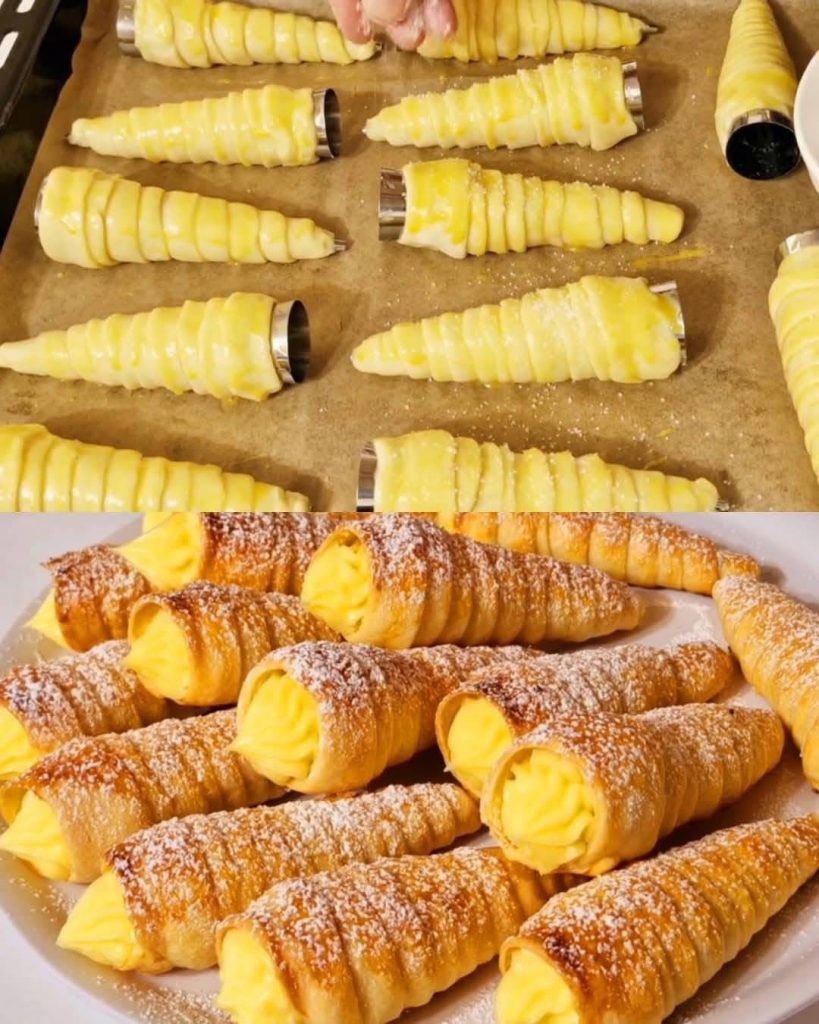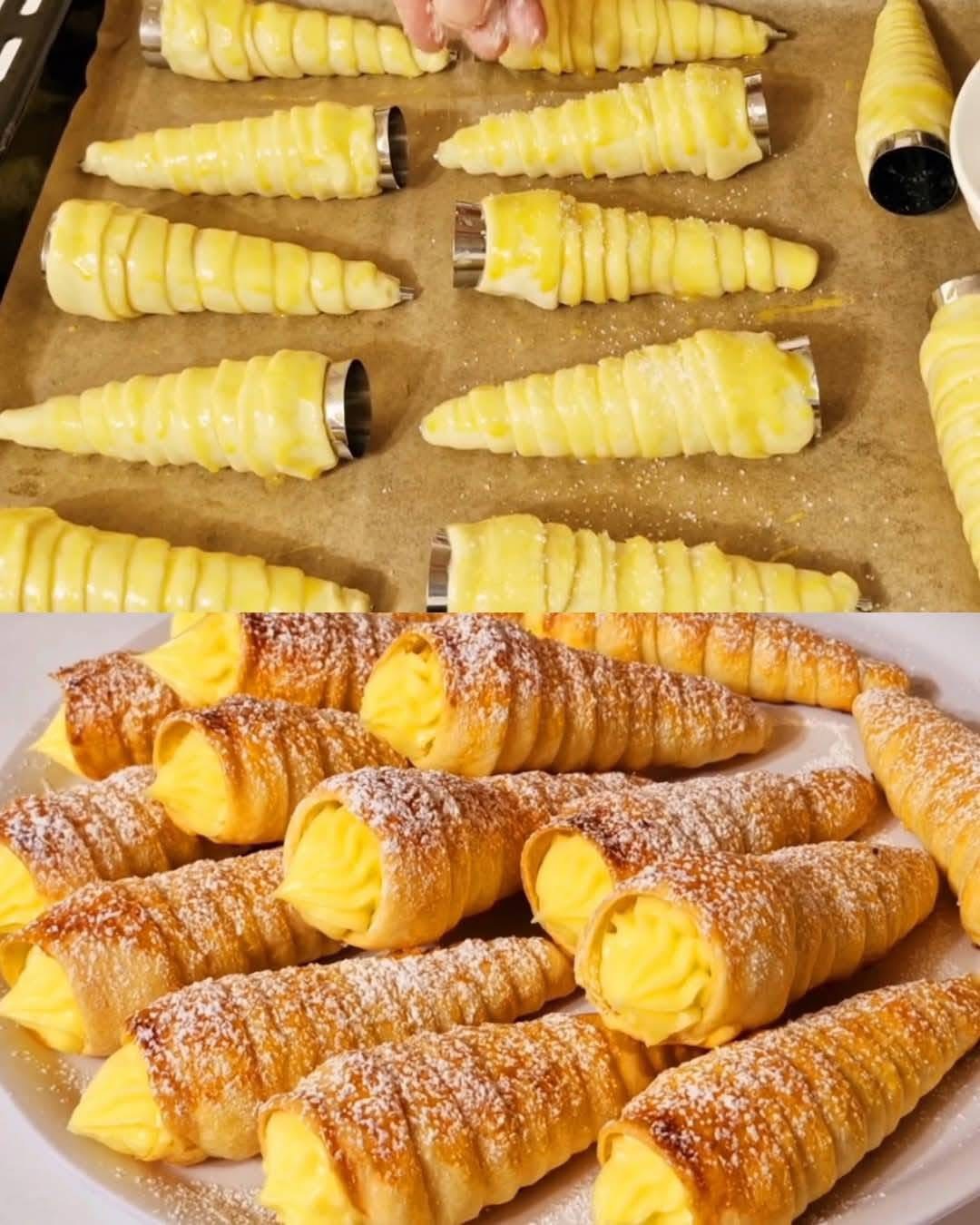
🥐
CUSTARD-FILLED CREAM HORNS
A golden spiral of flaky puff pastry filled with silky-smooth vanilla custard.
🧾
I. Introduction
Cream Horns are elegant, cone-shaped pastries traditionally made with puff pastry wrapped around a metal mold, baked until crisp and golden, and filled with rich, luscious cream. Their visually appealing form and delightful texture contrast — crispy shell and creamy core — make them a favorite in bakeries and patisseries around the world.
Whether served at a wedding, holiday table, or afternoon tea, these pastries offer sophistication and comfort. This recipe provides a modern yet authentic take on the classic cream horn with homemade vanilla custard filling, balancing decadence with tradition.
🧂
II. Ingredients
🌀 Puff Pastry Horns
- 2 sheets of puff pastry (store-bought or homemade)
- 1 egg (for egg wash)
- 1 tablespoon water (to mix with the egg)
- 2 tablespoons granulated sugar (for dusting)
- Butter (for greasing the molds)
🍮 Vanilla Custard Filling
- 500 ml whole milk
- 4 egg yolks
- 100 g granulated sugar
- 40 g cornstarch (or custard powder)
- 1 teaspoon vanilla extract or ½ vanilla bean pod
- 25 g unsalted butter (optional, for richness)
🍧 Topping
- Powdered sugar (for dusting)
- Optional: grated chocolate or fruit jam for garnish
🛠️
III. Equipment Needed
- Cream horn molds (metal cones or rolled foil)
- Whisk
- Saucepan
- Baking tray
- Parchment paper
- Pastry brush
- Mixing bowls
- Piping bag with star or round nozzle
🔪
IV. Instructions
Step 1: Prepare the Pastry
- Preheat your oven to 200°C (392°F).
- Lightly butter the cream horn molds.
- Roll out puff pastry into a rectangle (if not pre-rolled). Cut into 1-inch (2.5 cm) wide long strips using a pizza cutter or knife.
- Wrap each strip around the mold in a spiral, overlapping slightly with each turn.
- Place the horns seam-side down on a baking sheet lined with parchment paper.
Step 2: Egg Wash & Sugar Dusting
- In a small bowl, beat 1 egg with 1 tablespoon of water.
- Brush each pastry horn with egg wash using a pastry brush.
- Lightly sprinkle granulated sugar over each horn.
Step 3: Bake
- Bake in the preheated oven for 15–20 minutes or until golden brown and puffed.
- Allow to cool slightly, then gently twist to remove from molds.
Step 4: Make the Vanilla Custard
- In a bowl, whisk egg yolks, sugar, and cornstarch until smooth.
- Heat milk in a saucepan until steaming (not boiling).
- Slowly pour hot milk into the egg mixture while whisking to temper the eggs.
- Return the mixture to the saucepan and cook on medium heat, stirring constantly until thickened.
- Remove from heat, stir in butter and vanilla extract. Let it cool completely.
- Once cooled, transfer to a piping bag.
Step 5: Fill and Serve
- Pipe the custard into cooled pastry horns from the larger end, filling completely.
- Dust with powdered sugar before serving.
- Optionally garnish with fruit jam, melted chocolate, or nuts.
🔬
V. Methodology
This recipe involves three essential culinary techniques:
1. Lamination (Puff Pastry)
- Lamination is the process of folding butter into the dough multiple times to create flaky layers. While store-bought puff pastry simplifies the process, the science of steam in the butter puffing up the layers remains.
2. Tempering
- Gradually heating egg yolks with warm milk avoids curdling. This technique ensures a smooth custard without lumps.
3. Piping
- Using a piping bag ensures consistent, neat filling. A star tip can add aesthetic value to the presentation.
🏛️
VI. History
Cream horns have European roots, closely tied to the rise of puff pastry and custard in 17th–18th century France and Austria. In Austria, they’re known as “Schaumrollen,” and often filled with meringue. In Italy, “Cannoli alla crema” use a similar horn shape with custard.
The invention of horn molds in the 19th century allowed bakers to make uniformly shaped conical pastries. Over time, they became popular across England and Eastern Europe, evolving in filling preferences from whipped cream to custard, chocolate, or fruit.
🧘♂️
VII. Benefits
✅
Health and Culinary Benefits:
- Calcium-rich: The milk and egg yolks in custard provide calcium for bones.
- Protein: Eggs and milk contribute to a modest protein content.
- Satiety: High fat and sugar content can satisfy hunger in small portions.
- Mood elevation: The texture and flavor of custard release dopamine-inducing reactions.
- Aesthetic appeal: Beautiful pastries enhance table presentation and impress guests.
🧩
VIII. Formation Process
Cream horns are formed by:
- Rolling pastry into strips.
- Winding around metal or foil cone molds.
- Egg washing and sugar dusting.
- Baking until golden and puffed.
- Removing molds, leaving hollow cones.
- Filling with prepared custard via a piping bag.
- Decorating with sugar or creative garnishes.
🔚
IX. Conclusion
Cream Horns combine the delicate artistry of pastry making with the comfort of creamy desserts. Their striking spiral shape makes them the centerpiece of any dessert tray. Versatile in filling and stunning in form, they’re a celebration of texture, balance, and baking tradition.
Whether you’re crafting them for a family celebration or as a treat to enjoy with coffee, these pastries never fail to impress. Make them once, and they’ll become a requested favorite.
❤️
X. Lovers of Cream Horns
👥
Who Enjoys This Dessert?
- Pastry chefs: For its elegance and technical challenge.
- Children: For the sweet, creamy interior and fun shape.
- Tea party hosts: Perfect for pairing with coffee or tea.
- European dessert fans: Especially those from Austria, Italy, and France.
- Home bakers: A rewarding recipe that looks as good as it tastes.
🍽️
XI. Nutrition (Per Serving – Approximate)
| Nutrient | Value |
| Calories | 230–260 kcal |
| Carbohydrates | 22–26 g |
| Sugars | 12 g |
| Protein | 4 g |
| Fat | 14 g |
| Saturated Fat | 7 g |
| Fiber | 0.5 g |
| Calcium | 40 mg |
| Cholesterol | 85 mg |
| Sodium | 100 mg |
Note: Nutritional values vary based on pastry thickness and custard quantity.
📜
XII. Final Conclusion
Cream horns are more than just a dessert — they’re a culinary legacy wrapped in buttery layers and filled with tradition. Rich, beautiful, and endlessly customizable, they exemplify how simple ingredients can become extraordinary with care and creativity.
d
